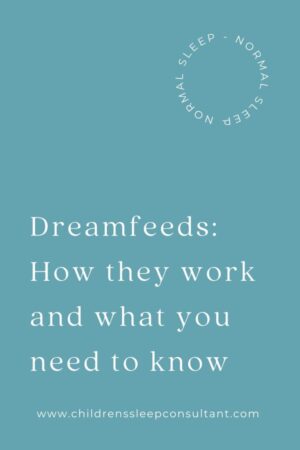Dreamfeeds: how they work and what you need to know
Dreamfeeds often come up in conversations with families, and many new parents have questions regarding how to make them work. Hopefully, this post will tell you all you need to know.
What is a dreamfeed?
A dreamfeed is, quite simply, a feed during which your baby is not fully awake; some babies will not even stir as they are fed. Similarly, some babies may wake during a dream feed but usually go back to sleep quickly.
Why dreamfeed?
The theory is that you give your baby a feed just before you go to bed so they can sleep for an extra 4 to 6 hours without waking for food. In return, you also sleep for 4 to 6 hours without being woken for food!
Do dreamfeeds really work?
As with anything, it all depends on your baby. For the majority, being gently woken enough to latch onto a breast or bottle and then being allowed to suck and swallow whilst drowsing is an excellent way to get a few more hours of sleep during the night. For some, being woken to feed before it is time can be hugely disturbing and not the right path. No specific scientific evidence suggests that dream feeds are the answer to a good night’s sleep, but the option is there to give it a go!

How to do a dreamfeed
If you do want to give dreamfeeding a go, here are some tips to get you started:
-
- Choose your time. This will depend on the time of the last feed and the latest time you can manage before falling asleep! If your baby fed at 7 pm, a dream feed at 11 pm is reasonable. If your baby last fed at 8 pm, 11 pm may still be ok- you are the best judge of this.
- Be mindful of sleep cycles. Your baby will be in their deepest sleep during the first part of the night and may not be able to wake enough for a feed, although most babies will wake just enough to feed.
- Keep the environment dim and peaceful. It goes without saying, but don’t speak to your baby, turn on lights or make lots of noise during a dream feed. The idea is to allow your baby to fall back to sleep as they feed.
-
- Only wake your baby enough for them to latch on. Gently lift your baby and hold them in your arms for the dreamfeed, ensuring you don’t move too much.
- If your baby doesn’t wake easily, try gently stroking the cheek with a nipple or teat to stimulate the rooting reflex. If this still does not work, try gently stroking the sole of the foot or the hand.
- If your baby still does not want to wake up for a dreamfeed, leave it for that night and try the next day again.
Benefits of dreamfeeds
- If you breastfeed, you can express a bottle, and partners can take over this particular night feed. For mums, this means you can go to bed earlier, ahead of the middle of the night/ early morning feeds.
- You may get an extra 4 to 6 hours of uninterrupted sleep!
There are also a few cons to dreamfeeds, and some families find that it does not work for them. It’s up to you to decide whether or not this method is going to be useful. You may want to bare in mind the following:
-
- Some babies will wake up and so dreamfeeds may need to be taken at a different time or abandoned altogether
- Some babies take a week or so to settle into the new routine of taking a dreamfeed. Allow for this and see where you are after a week.
- Some babies may not respond well to having their natural feed cycle interrupted. If your baby is unhappy after a week and dream feeds are causing more disruption than extra sleep, you may want to re-think your approach.
- Some babies may wake more frequently after they have been woken for a dreamfeed.
Do you dreamfeed your baby, or are you thinking of doing so? I’d love to hear from you!




